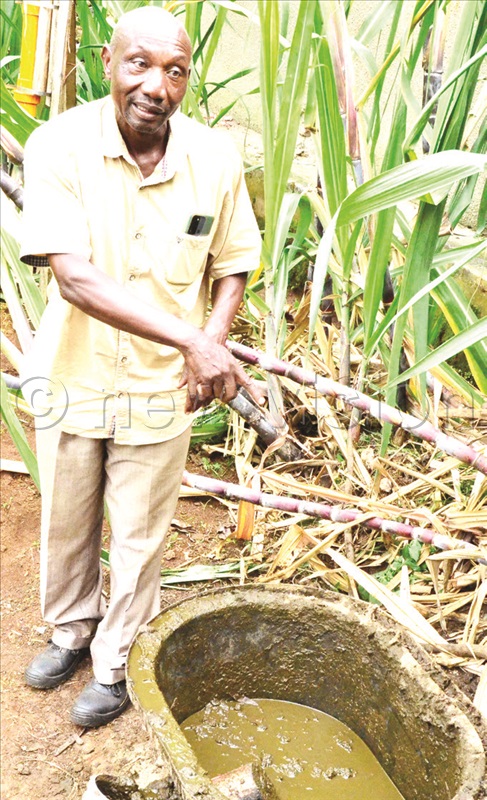By Herbert Musoke
Cox Nyakairu and his family used to cut three trees every month for firewood, which saw his land get depleted of trees until he got biogas, which has made the cooking process environmentally friendly and economical.
A former resident district commissioner of Kabarole, Kyegegwa, Luwero, Mbale and Kabale explains that at his home in Kazingo-Fort Portal, he would spend about sh150,000 a month on fuel since he was cutting down his trees.
“This to, an average Ugandan, is expensive and destroys the environment, which has caused prolonged drought and hot conditions,” Nyakairu says.
In the fight against global warming through climate-smart farming and cooking systems, Nyakairu lauds the bio-gas programme promoted by Sistema Bio, which aims at creating value from livestock waste.
For years, Nyakairu has been a dairy farmer, but he was using cow dung for manure only.

He would let the dung decompose for some months before using it, yet he could have used it for biogas and the bio[1]slurry for fertiliser and pesticide.
Biogas is a cost/lifesaver
Gladys Akiiki, Nyakairu’s wife, explains with gratitude that since the installation of biogas system in her home, she has become the happiest wife.
Akiiki can cook safely without smoke, which would always require her to take a bath after meal preparation. The smoke also affected her health.
“I used to tell people that my lungs are as black as my soot-coated kitchen walls. The smoke would make one prone to respiratory diseases such as cough, flu and lung cancer,” she says.
Akiiki says she would usually take a bath before cooking.
However, because of the smoke, she had to have another bath after working in the kitchen. She can now make millet bread kalo for the family and serve it hot without fear of the smoke smell.
Similarly, Abel Nabimanya and his wife, Beatrice, of Rwanduma, Rwenjeru ward in Mbarara city are happy with biogas, which has saved their farm’s trees.
“We had begun to worry because the whole farm was becoming an open field after most of the trees had been cut down for firewood. We resorted to buying firewood. A piece would go for sh2,000, yet we needed about 10 pieces each day,” Nabimanya explains.
He adds that this, therefore, meant that each day he would spend sh20,000 on firewood and sh600,000 each month.
David Mwesigwa, the Sistema Bio marketing co-ordinator, says they are implementing the Uganda Dairy Biogas programme to boost small and medium dairy farms through partnerships with local dairy organisations and businesses.
The programme will contribute to the 2030 agenda for Sustainable Development Goals, eliminating more than 1.5 million metric tonnes of carbon emissions over the project’s five-year life.
Mwesigwa says livestock farmers have been losing more from dung than they can imagine, starting with biogas for cooking and bio-slurry. He says a 12-cubic-metre gas tank costs sh1.5m.
The tarpaulin-like tank is much easier to install and maintain. In case of any malfunction, only a few parts are checked.
Sistema Bio is implementing the programme with partnerships from the Uganda Crane Creameries Co-operative Union, African Biogas Component, Rural Environment Sustainable Initiative, ENVenture, Renewable Energy Business Incubator and Nyonta Relief.
Mwesigwa says over 600 systems have been installed across the country since the project was launched in September 2022.
They aim to install 100,000 systems before its closure.
Collecting dung for biogas
Cow dung is deposited and mixed inside a collection tank until it becomes a homogeneous slurry. The biomass is then fed into sealed tanks (digesters), where anaerobic digestion occurs.
Microbes break down the organic matter, producing methane and other gases. In the final stage of the process, the gas can be purified (upgraded) by removing contaminants and carbon dioxide. Fresh organic matter must be introduced to the digester regularly for the best results.
Is dung biogas sustainable energy?
Overall, turning cow dung into renewable energy makes sense environmentally and economically. A single cow produces 29.5kg of waste each day.
Cow dung is residual matter; it cannot be used to feed other animals. It introduces significant amounts of methane into the environment and presents a health risk if not adequately managed.
Processing this waste to obtain biogas is considered a sustainable waste management solution.
Moreover, it provides cheap gas to communities in developing areas. However, generalisation can be dangerous as the profitability and sustainability of the process depend on the amount of waste a farm needs to recycle and the existing infrastructure that makes biogas easy to use for cooking.
Advantages of cow dung biogas
- It is an eco-friendly, renewable energy source that can reduce greenhouse gas emissions.
- It reduces water and soil pollution, keeping cow dung out of landfills.
- It encourages a circular economy and gives access to clean energy in developing areas.
Cow dung biogas disadvantages:
- Costs of biogas production are high, between upfront expenses and system maintenance.
- Biogas production can be time-consuming.
- Most systems require significant volumes of cow manure, which often arrives from multiple sites.
Effective waste management
Effective dung waste management is one of the most important things farmers can do for the health of the animals, families, land, water and environment.
Besides making cow dung biogas one can also make compost. Cow manure is nutrient-dense and ideal for plant growth, so composting it to make organic fertiliser is an effective method for recycling these residues.
Most compost piles use aerobic digestion to break down waste, but anaerobic can also be used.
Cow dung compost is a 3-2-1 NPK fertiliser containing 3% nitrogen, 2% phosphorus and 1% potassium, making it suitable for most crops and the restoration of nutrition.
LEAD PHOTO CAPTION: Beatrice Nabimanya and her husband, Abel Nabimanya (right), showing their biogas plant.





